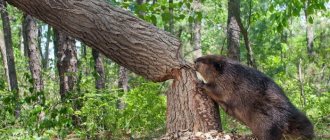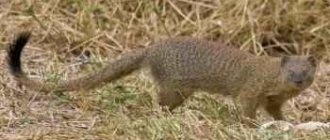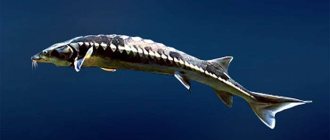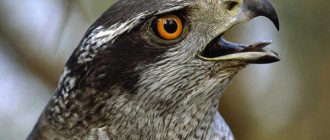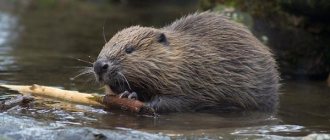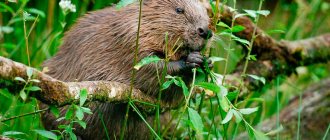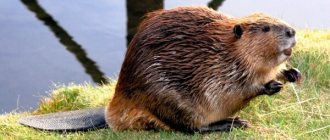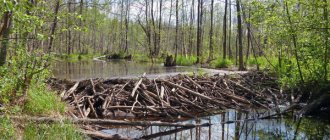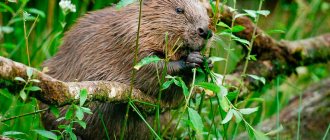River beavers are considered sweet and good-natured animals exclusively for those who have never encountered the results of their fruitful activity. Many foresters have found themselves in not the most pleasant situations due to the work of these hard-working rodents. In addition to the signal posts in the forest damaged by sharp teeth, water bodies are also affected. Dams and ponds built by beavers create large flooded areas. In the current situation, nature receives many disadvantages. In addition to wetlands and trees dying from excess moisture, damage is caused to fish representatives. Through beaver dams, it is impossible for fish to move through the waters of rivers, which negatively affects its population and also sometimes interferes with proper spawning.
Description
Common beavers weigh from 13 to 35 kg. The body length is 73-135 cm, and the height at the withers is up to 35 cm. They have two layers of fur: the first is a soft and dense undercoat, dark gray in color. The outer (second) layer is longer, with coarse reddish-brown hair or guard hairs. Northern populations have a darker coat color. River beavers have two castoreum glands located near the anal region. These glands produce an aromatic, chemical called beaver squirt, which is used to mark territories. The muzzle is blunt, the ears are small, and the legs are short. Both ears and nostrils have valves, and the eyes have a nictitating membrane.
The tail is bare, with black scales, and the shape is wide, oval and horizontally flattened. The color of the paws varies from dark brown to black, each with 5 toes. The hind feet have webbed toes, and the inner two toes are joined at the base and are used for grooming. In their mouths, beavers have a fold of skin that allows them to chew on branches underwater without getting water into their mouth. They have two, large, orange incisors. Females and males look similar to each other, although females are larger.
Area
Eurasian beavers once densely inhabited all of Europe and Asia. However, excessive killing of animals for fur and beaver dross, as well as habitat loss, have significantly reduced the population, almost to the point of extinction. In the 19th century, there were no beavers left in most countries of Europe and Asia. In the 20th century, there were approximately 1,300 beavers in the wild. Control and reproduction efforts have led to an increase in the European beaver population. Currently, beavers live in France, Germany, Poland, southern Scandinavia and central Russia. However, their populations are small and scattered throughout these areas.
Beaver Dams
river beaver dam
Beavers build dams competently and reliably. The record is considered to be a dam about 680 meters long, built in North America. Creating such a structure without a single tool requires a lot of effort, as well as a competent approach.
Beavers differ from some animals in one feature. As it became known, the life of a beaver in unnatural conditions is much longer than in nature. In properly created enclosures, some individuals can easily live for several decades. In Europe, measures have been taken to protect the beaver since the beginning of the 20th century. In our country, in the early 60s of the twentieth century, the number of individuals increased significantly, so legal hunting began for the animal.
These are the hard-working and smart beavers they are. Their competent judgment and ability to work is worth the envy of many representatives of the animal world. However, their activities do not always benefit humanity and nature as a whole.
River beavers are dangerous. Two years ago, three fishermen saw a beaver in a field and decided to take a photo with it. The photo session ended in tragedy. A beaver bit an artery in one fisherman's leg and he died.
See the entry FISH FALCON
Habitat
Stream beavers are semi-aquatic animals and live in freshwater systems, including lakes, ponds, rivers and streams, usually in forested areas, but sometimes in swamps. Constant access to water is essential, and the preferred tree species are willow, aspen, birch and alder. Beavers select slow-moving, calm or deep waters and can create these conditions if necessary. Water quality is less important than access, food availability, and depth.
Where does it live?
The river beaver inhabits the basin of the Konda and Malaya Sosva rivers. Small populations can be found on the Yerkal-Nadey-Pur River and in the upper reaches of the Great Yugan. This mammal inhabits the dark coniferous taiga, which is located on the West Siberian Plain. The river beaver also inhabits reservoirs next to which there are birch groves. The ideal option for animals is a birch forest on one side of the pond and a forest on the other. In such places it is convenient to create burrows for wintering.
Reproduction
Common beavers are monogamous. The female's estrus lasts from January to February, but sometimes warm winter weather can lead to breeding as early as December. Most often, mating occurs at night, in water, but in some cases it also happens on land. The duration of copulation ranges from 30 seconds to 3 minutes. If the female is not fertilized the first time, she goes into repeated estrus (2 to 4 times) throughout the breeding season. All family members take part in raising the offspring.
The gestational period ranges from 60 to 128 days. A female gives birth to 1 to 6 cubs, but most often 1-3. Newborn beavers weigh 230-630 g. As a rule, feeding with mother's milk lasts up to 6 weeks. During this time, the female takes care of the cubs, cleans them and feeds them. After the young are weaned from their mother's milk, other family members help feed them by bringing small twigs and soft bark until the young are about 3 months old. At 1.5-2 years, young beavers gain independence, leave their parental family and create their own.
Interesting fact
In the early 40s, some areas of the United States were faced with the problem of the impact of beavers on territories that had begun to be developed by humans. The issue was particularly acute in Idaho.
The problem for settling new lands was created by dams built by beavers from fallen trees. It was decided to relocate beavers to areas remote from people, where beavers could positively influence the ecological state of aquatic and riverine biotopes.
An area in the center of the state, in a large nature reserve, was allocated for the relocation of beavers. This territory was characterized by the fact that it was difficult to access by wheeled transport.
The solution to transfer beavers was proposed in 1948 by conservation officer Elmo Heather. The method he proposed was to drop beavers from parachutes. Heter designed a wooden box with holes for ventilation that opened when it hit the ground. Heter also found cargo parachutes left over from World War II in military warehouses. They carried out a test series of flights to release a beaver named Geronimo. The beaver was dropped from an airplane onto a field and repeated many times. In the field he was caught by his handlers and put back in the box.
Based on the results of successful experiments, the management of the environmental service agreed to parachute drop of 75 beavers into the reserve.
The film, chronicling the beaver transfer operation, was stored in the Idaho State Archives and was discovered only in 2015.
It is worth noting that at the present stage, beavers also continue to be transported in Idaho for reasons of environmental expediency, but such methods are no longer used.
Nutrition
River beavers are herbivores; during the winter months, they feed mainly on woody vegetation. Beavers prefer willow, aspen, and birch with a diameter of less than 10 cm. In the fall, rodents stock up on these foods and store them in water to eat in the winter until the ice melts. During the summer months, common beavers feed on aquatic vegetation, shoots, twigs, bark, leaves, buds and roots. In agricultural areas, rodents consume agricultural crops. Beavers do not have cellulase, an enzyme used to process cellulose. However, beavers feed on excrement, as a result of which the intestinal microflora is able to digest cellulose.
Behavior
Common beavers are primarily nocturnal, although they can be active during the day. Their burrows are usually located on the banks of rivers or ponds. In huts, beavers live in families of up to 12 individuals. These families consist of only one dominant, monogamous couple. The dominant female decides when young beavers leave the family. Beavers are semi-aquatic rodents and can remain underwater for 4-5 minutes. They are active throughout the year. In the northern regions, these animals do not come to the surface of the ice. For this reason, beavers spend the fall season gathering food so that they have something to eat during the winter. The reserves consist of woody vegetation such as willow and aspen branches.
Beavers can change the speed of currents and the depth of water through construction. However, Eurasian beavers are more conservative than their North American cousins, the Canadian beavers, and tend to build significantly fewer dams and lodges. Common beavers are very territorial and mark their territory with beaver streams. Beavers are very aggressive towards unknown odors on their mounds, often hissing and slapping their tails in the water. Most often they will leave their scent on or near the mound.
River beavers must take care of their fur and constantly maintain its water-repellent properties. They use the split toes of their hind feet and distribute oil from the sebaceous glands to the guard hairs. This makes the outer coat waterproof and the undercoat never gets wet. Without these fats, beavers would not be able to spend as much time in water or withstand low temperatures.
Home range
The size of a beaver's home range depends on the abundance of food, the size of the river basin, the size of the family, and the time of year. During the winter months, the home range is equal to the area that a beaver can patrol underwater daily in a single trip, since ice cover is present. During warmer months, the home range size can be 1-5 kilometers along the coastline.
A few more interesting facts
- In the city of Bobruisk (Belarus) in 2006, a sculpture of a beaver was unveiled. A little later - another one.
- A sculpture of beavers is unveiled at the Alpine Zoo in Innsbruck, Austria.
- The beaver sculpture is also located above the entrance to the Canadian Parliament building.
- In April 2016, in Latvia, a beaver attacked a man, grabbed his leg, knocked him down and held him on the ground, preventing him from getting up. The victim was saved only with the intervention of the police.
- On July 1, 2008, as part of the “Save Our World” coin series, the Bank of Russia issued 8 commemorative coins made of precious metals dedicated to the beaver.
- The image of a beaver can be found on the coats of arms of many municipalities (communities and cities).
Threats
Huts and burrows provide beavers with reliable protection from predators. Until now, the biggest threats to ordinary people are people. The rodents were hunted for their valuable pelts and beaver stream, which led to almost extinction. Currently, thanks to conservation efforts, beaver populations are protected by law. Poaching, being caught in nets, and road accidents are the main causes of death for these rodents. Natural predators include wolves, brown bears, and red foxes. Today, one of the main causes of mortality of river beavers is infectious diseases.
Origin of the species
Unfortunately, most people know about this animal only by hearsay. Not everyone can even pronounce its name correctly. For example, the word "beaver" is confused with "beaver". Meanwhile, the second word denotes the name of the fur of this animal. Although in spoken language no one adheres to these rules anymore.
The beaver family is known on different continents. There are 22 genera known, and for the first time this species of animal appears in Asia. Some varieties were very large. To this day, fossilized remains have been preserved, which scientists date to the Eocene.
The most famous beaver, the species of which disappeared a long time ago, is a giant that existed during the Pleistocene. Science knows about two of its varieties - the Siberian Trogontherium cuvieri , as well as the North American Castoroides ohioensis.
If the calculations were carried out correctly, then, according to the fossil skull, the height of the animal reached 2.75 m, and its total mass was 350-360 kg. That is, it was similar in size to a brown bear. The modern species of beaver used to live in Europe and Asia, almost everywhere in the forest-meadow zone. But by the beginning of the 20th century, this animal was practically exterminated in most of the planet because of its valuable fur.
Role in the ecosystem
Common beavers have an extraordinary ability to impact ecosystems. Through the process of building dams, they change the flow of water, which leads to the flooding of many hectares of forest land. The decrease in nitrogen and acidity along with the increase in carbon inhibits the growth of woody vegetation for some time, but eventually the trees begin to grow and the forest recovers. Dams collect waste and debris, which increases carbon and decreases nitrogen and acidity, altering invertebrate habitats. This new source of water attracts various species of birds, fish and amphibians. River beavers also control woody vegetation. Submerged wood dies within a year and then becomes part of the aquatic ecosystem.
River beavers act as hosts for 33 different species of ticks, which can live on rodents at any time of the year.
Economic significance for humans
Positive
Eurasian beavers have valuable fur, meat and beaver stream. Previously, skins were used as currency until the animals almost disappeared. Fur was used to make clothing, felt, and felt hats. Beaver stream was used as a medicine and a base in perfumery. Beaver meat has nutritional value. In the 16th century, the Pope argued that the beaver's scaly tail and semi-aquatic lifestyle made it a fish and could be eaten during Lent. Even today, in Europe, about 400 tons of beaver meat are consumed during Lent.
Negative
Common beavers are considered destroyers, cutting down trees and flooding areas. The most numerous complaints are related to flooding of agricultural lands and, as a result, destruction of crops. Beavers flood roads and drainage pipes, causing serious damage.
Beaver stream, or castoreum
The anal preputial glands of beavers produce an aromatic substance that has been used for medicinal and cosmetic purposes since ancient times. It is called beaver stream or castoreum. Animals use it mixed with urine to mark the boundaries of their territories.
They are extracted from killed animals and cleaned of blood, fat and flesh. After drying, they are ready for further use. Most often they are ground into powder and infused with alcohol and vodka. The resulting drink is considered a tonic and is used to treat many diseases.
Beaver stream is traditionally used for headaches, colds, epilepsy, diseases of the cardiovascular and respiratory systems. Its analgesic and antipyretic properties are explained by the high content of salicylic acid. It accumulates in the glands due to the active feeding of willow branches (Salix) by the rodent.
For a long time it was considered a panacea for all ailments. According to legend, its inventor was the Pontic king Mithridates VI Eupator. Regular use of this drug made him immune to poisons. As a result, he was unable to poison himself while trying to avoid capture by the rebels. He had to ask his bodyguard for a long time to kill himself with a sword.
In the Middle Ages, beekeepers used beaver smoke to scare away bees while collecting honey. As a flavoring agent, it was added to snuff, drinks and some dishes. They give them pungency and a slight bitterness.
The main consumer of beaver stream remains the perfume and cosmetics industries. It is added to luxury perfumes, soaps, powders and cosmetics. It imparts an aroma reminiscent of leather and valerian.
